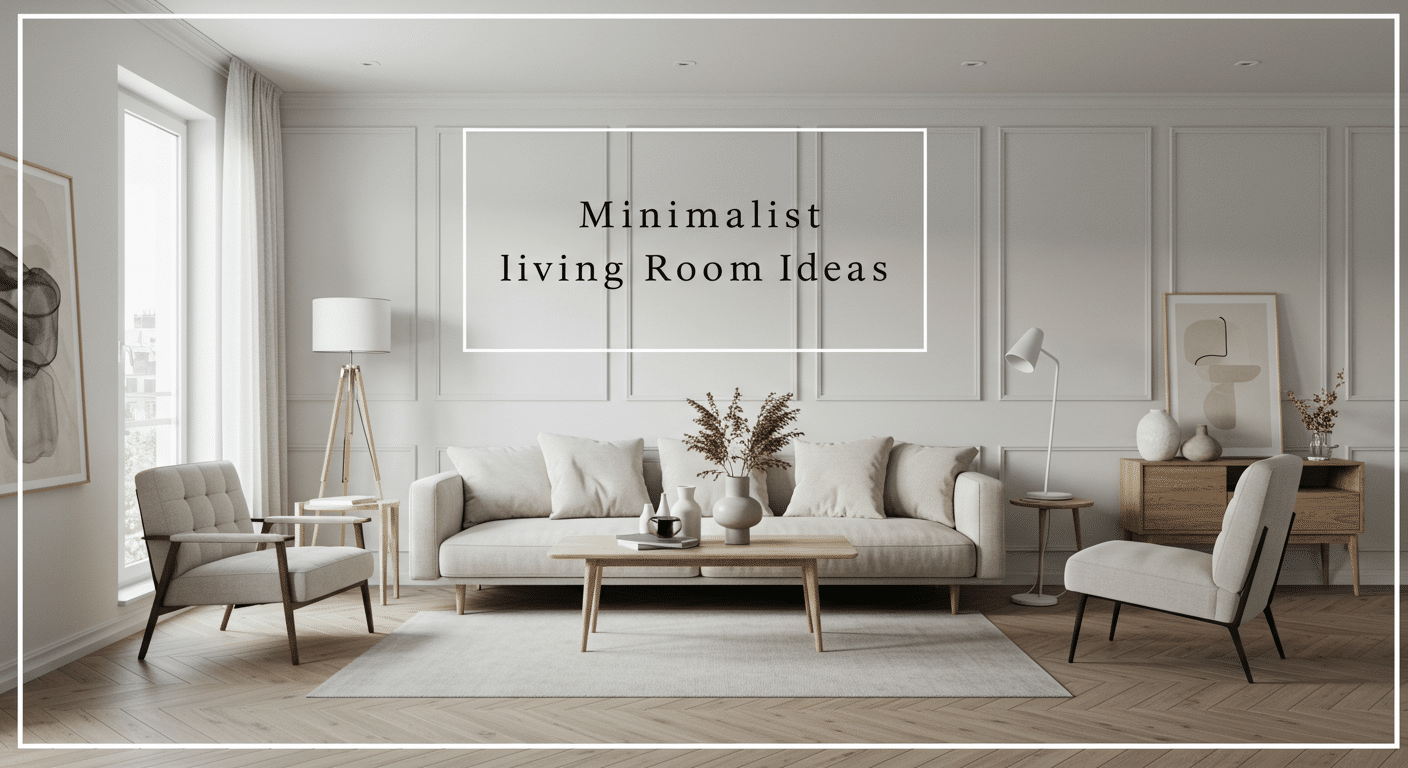Minimalism is not just about having less. It’s about breathing better in your own space. When you walk into a room and feel like your shoulders drop a little, that’s the magic of a minimalist living room done right. It doesn’t shout, it doesn’t try too hard. It just quietly exists, and that’s exactly what makes it so powerful.
A minimalist living room can still feel cozy, warm, and alive. It’s not the cold empty space people sometimes imagine. With the right balance of light, texture, and thoughtful objects, you’ll discover how little you really need to feel at peace. And maybe, just maybe, you’ll find that your inner zen has been waiting all along, under all the clutter.
1. Choose Calm Colors That Whisper, Not Shout
The color of your walls sets the tone for everything else. White is the obvious choice, but don’t stop there. Muted grays, pale beige, or even a soft sage green can feel like a hug for your eyes. The trick is to go for tones that don’t scream for attention.
Think about how you feel when you step into a spa. The colors are never neon or bold. They’re calm. They let your mind settle. That’s what you want in your living room. A color that doesn’t just look nice, but also makes your brain stop buzzing for a moment.
Sometimes people are scared of “boring” walls. But boring is not the word here—peaceful is. Add a little texture with plaster, limewash, or matte paint. Suddenly, plain walls feel alive.
2. Keep Furniture Simple But Not Soulless
Minimalism doesn’t mean you have to buy a plain boxy sofa that looks like it belongs in a waiting room. It just means your furniture should have a purpose and a bit of quiet elegance. Pick a sofa that feels comfortable and doesn’t overwhelm the room. Slim legs, soft fabrics, and clean lines usually do the trick.
Coffee tables are another story. Instead of some bulky thing with drawers and heavy edges, try a round wooden one, or even a stone top with thin legs. The table should almost float in the space, not block it.
And chairs—oh, the chairs. A single lounge chair with a sculptural shape can bring character without adding clutter. You don’t need five different side chairs just to prove the room is complete. Sometimes one is enough, and it says more than many ever could.
3. Embrace Empty Space
This is the hardest part for most people. They feel the need to fill every corner, every wall, every shelf. But space itself is an element of design. It gives the eye a place to rest. It creates balance. It actually makes the few things you do own stand out even more.
When you leave a section of the wall empty, it feels intentional. It feels like you’re letting the room breathe. You can almost hear the silence. That’s where the zen comes in.
If you’re used to clutter, this part will feel uncomfortable at first. You’ll look at that bare wall and think something’s missing. But give it time. After a while, you’ll realize nothing’s missing at all.
4. Light Is Everything
A minimalist living room without good lighting is just… flat. Natural light is your best friend, so keep window treatments light and airy. Sheer curtains or no curtains at all, if privacy allows. Sunlight should be allowed to spill in and wash over the room.
At night, avoid harsh overhead lights that make you feel like you’re in a supermarket. Instead, layer soft lighting. A floor lamp in one corner, a small table lamp glowing warmly, maybe even candles. Light should be gentle, like a friend whispering instead of yelling.
You’ll notice how different the room feels at different times of the day. Minimalism is really about noticing those small shifts, those quiet moods that light creates.
5. Pick Decor With Meaning
Minimalist decor doesn’t mean no decor. It just means being picky. Instead of filling shelves with random knick-knacks, choose one or two pieces that matter. A ceramic vase you found while traveling. A framed photo that still makes you smile. A handmade bowl with texture.
These pieces become stronger when they’re not competing with a million other objects. It’s like giving them a stage.
Plants can also count as decor, but don’t go wild. A single large plant in the corner can be enough. It adds life, movement, and a bit of unpredictability to an otherwise calm space.
6. Layer Textures, Not Stuff
Minimalism can sometimes feel too plain if you’re not careful. That’s where textures save the day. A linen throw on the sofa, a chunky wool rug under your feet, a wooden side table that feels warm to the touch. These little differences in texture add depth without clutter.
It’s not about having more, it’s about choosing better. One soft rug under the coffee table feels more grounding than three smaller ones scattered around. A single, oversized cushion can sometimes feel richer than a pile of mismatched pillows.
Textures make you want to touch things, to experience the space, not just look at it. And that, in itself, feels zen.
7. Hide The Mess
Let’s be honest, nobody’s life is truly clutter-free. We all have chargers, remote controls, half-read books, maybe a cup that’s been sitting too long. The secret is not pretending these don’t exist. The secret is hiding them.
Closed storage is a minimalist’s best friend. A sleek cabinet with hidden shelves can swallow all the daily mess in seconds. Even a woven basket works wonders—throw in blankets, toys, or whatever you don’t want on display.
The idea is that when you walk into the room, you see calm. The chaos is still there, but it’s tucked away, waiting for later. Out of sight, out of stress.
8. Choose Art That Breathes
Art in a minimalist living room should feel like a pause, not like an explosion. Large, simple pieces usually work best. A single abstract canvas in muted tones. A black-and-white photograph. Even a framed line drawing that looks like it took two seconds to make—but feels timeless.
You don’t need a gallery wall with 20 frames. One piece, placed with intention, has more impact. It makes you stop and look, instead of scanning quickly and moving on.
And here’s the secret: art doesn’t have to be expensive. Sometimes the most calming piece is a simple print, even a DIY painting you tried one lazy Sunday. What matters is the feeling it gives you, not the price tag.
9. Think About Flow
Minimalist living rooms aren’t just about how they look, but how they work. The way you move through the space matters. If your coffee table blocks the walkway or your sofa feels crammed against the wall, it breaks the calm.
Try rearranging. Give your furniture breathing room. Even pulling your sofa a few inches away from the wall can change everything. Suddenly the room feels lighter.
Think of your living room as a path. When you enter, you should flow through it naturally, without bumping into corners or stepping around obstacles. That’s the kind of invisible detail that makes minimalism feel easy, not forced.
10. Make It Personal, But Quietly
Minimalism doesn’t mean stripping away your personality. It just means showing it in a quieter way. Instead of ten photo frames scattered across every surface, pick one big photo that tells your story. Instead of displaying your whole book collection, choose a few favorites and stack them neatly.
Your living room should still feel like you. The colors you love, the textures you find comforting, the objects that hold your memories. But it’s about editing—keeping only what matters, and letting go of the rest.
In the end, minimalism isn’t about rules. It’s about how the room makes you feel when you sit down after a long day. If it makes you exhale, if it makes you notice the quiet, then you’ve done it right.
Finding Your Zen In Simplicity
The thing about minimalist living rooms is that they’re not just about looks. They’re about what they do to your brain. Less clutter means less noise in your head. Calmer colors mean calmer moods. Soft lighting makes you softer inside, too.
And the funny thing is, once you start living with less, you realize you don’t even miss the “more.” The stacks of decor, the endless trinkets, the heavy furniture—you don’t think about them anymore. You think about how good it feels to breathe.
Minimalism is not a style, it’s a habit. A way of choosing what to keep close and what to let go. And once you get a taste of that quiet, it’s very hard to go back.

Dorothy is a design lover on a mission to make every space feel inspired — from cozy living rooms to stylish home offices. With a flair for blending comfort, creativity, and practical ideas, she shares decor tips that breathe life into homes, workspaces, and everything in between. Whether you’re revamping a bedroom or refreshing your office nook, Dorothy’s thoughtful ideas help you design spaces that reflect your unique style.
